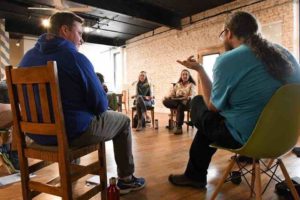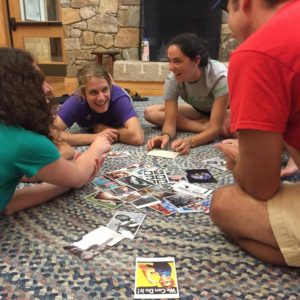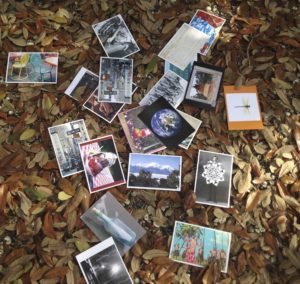Mar 13, 2018 Sequencing Reflection and Processing in the Middle of the Experience
In my last three posts, Meaningful Reflection Brings Learning to Life,Facilitating Reflection: Challenges and Opportunities, and Tips for Facilitating Meaningful Reflection I’ve focused on the art and science of facilitating reflection – an essential ingredient in teaching, team-building, and training. Today’s post continues on that theme with thoughts on intentionally designing the reflective aspect of your programs. Sequencing Reflection Excerpt from Tips & Tools for the Art of Experiential Group Facilitation

Effective facilitators put a lot of thought into sequencing their programs so that lessons and activities build upon the previous ones. They start with less intimidating methods to build comfort, trust, and rapport in the group before increasing the challenge.
I encourage facilitators to put the same kind of thought and planning into sequencing the reflective part of the experience. A former colleague used to tease me about planning ahead of time which reflective technique would best match the activity we were facilitating. That kind of planning has served my groups well (as long as I am flexible about changing the plan as needed). The brain research on multiple pathways to learning reinforces using a variety of modalities and methods in order to increases engagement and learning outcomes. In my work, I carefully sequence reflection, starting the moment the group walks in the door with a reflective hook activity (described in previous posts and chapter two of Tips & Tools for the Art of Experiential Group Facilitation) and beginning the dialogue with partners and small groups. This incremental introduction of reflective practice increases participants’ comfort with group process and reflection before asking them to share with the whole group.
We do not live in a reflective society. Many people are not used to being asked to think about their thoughts, feelings, and reactions to experience, let alone share them out loud. Reflection like other skills takes practice. Since making this simple shift as a facilitator, I find that when I do work up to a whole-group share out, it is much richer and more participants are involved because they have practiced and are now more comfortable and trusting of the people around them.
Processing in the Middle of an Experience Luk Peeters, a therapist and experiential educator from Belgium, once shared with me that he believed the optimal place to capture a lesson was WHILE it was happening. His comments sparked my thinking about how to take advantage of those opportunities. I had occasionally stopped groups in the midst of an activity to discuss and reflect when there was a breakdown in group process. After the conversation with Luk, I started making an effort to stop a group midway when things were going beautifully so they could remember what it felt like, looked like, and sounded like. Weave in some brief stop actions in the midst of a challenge for groups to identify what is working and celebrate the changes in their group process. This allows group members to take mental snapshots of important moments and specific behaviors and better apply the learning from those moments in subsequent activities. (In challenge course and other adventure learning situations, make sure the group is in a physically comfortable/safe spot for this mid-activity reflection.)

Integrate the use of metaphoric image cards and objects into the activity itself as a way to process midstream. Lay out cards or objects at a transition point in the middle of a program or group challenge. Ask participants to come to agreement on three cards that represent three essential skills or behaviors used in the activity/project that they think will be useful in upcoming experiences. I often (especially with younger groups) have them carry these cards or objects with them to the next activity, and I’ve noticed they pull them out as a reminder, mid-activity, when the group starts falling into old habits. I find ways to integrate them into the next activity or refer back to them to illustrate transfer of skills/learning to future situations.
Objects/images can also be used to frontload an activity. For example, I’ve used tools or objects to initiate reflection on goals and frame the experience at the very start of a problem-solving task such as the challenge course activity, Nitro Crossing (Rohnke, 1989), in which a team works together to swing across “treacherous waters” to reach a platform. Begin by asking participants to choose objects that represent goals for their program, workplace, or another relevant theme, and then make this part of the challenge itself by placing the objects on the platform. The resources and obstacles encountered by the group on the way to reaching the platform can represent the resources and obstacles that come up in real life. When groups reach the platform and share their objects and corresponding goal, the level of engagement and meaningful communication is greater than if we waited to sit down afterward to discuss the group’s progress.

In a multi-phased, problem-solving challenge where groups work together to navigate various obstacles, the metaphoric images or objects can be integrated as a reflective part of the challenge itself. Lay out objects or cards mid-way through the challenge and ask group members to them to collaborate on creating a timeline or story of their experience. There are many creative ways to integrate reflective practice into the action phase of learning. Mix-up your methods and take advantage of the energy and emotion of a group that is actively engaged in a challenge, problem or task.
References: Rohnke, K. Cowstails (1989) and Cobras II. Dubuque, IA: Kendall Hunt.



No Comments